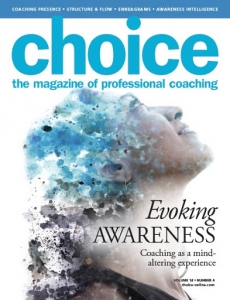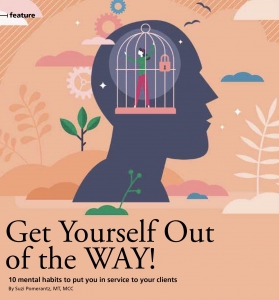
What does it really take to help your clients evoke awareness, expand and shift their perspectives, and truly leverage coaching as a mind-altering experience? What mental habits do you need to cultivate to best serve the clients you support? The short answer is: get yourself out of the way. The article below was first published in, and reproduced with permission from, choice, the magazine of professional coaching.
At its core, coaching is about evoking awareness and shifting mindsets, reflecting a client’s beliefs or limitations, to cause an expanded freedom to choose. The 10 mental habits of master coaches that enable you to get yourself out of the way and be in service to your clients’ agenda include:
- Cultivate and sustain a beginner’s mind. The most powerful phrase you can use in coaching is “I don’t know, let’s explore it together.” If you come to your clients from a place of knowing, even with the best intentions, you are not coaching, you are being an expert. Sharing information is teaching. Sharing benchmarks is consulting. Sharing models and methodologies is training. Sharing guidance is mentoring. Sharing personal stories is friendship. Don’t get me wrong, masterful coaching may at times leverage all of these skills, however your ability to cultivate and sustain the not knowing will create a more reflective space for your client to step into and grow. Keep yourself in a beginner’s mind by sitting in your awareness of your desire to show how knowledgeable and how clever you are, then from that consciousness, shift yourself sideways to the place of being with the client, rather than giving to the client. Remind yourself that they are the expert on themselves, and you are a beginner, helping them see and connect new dots. Stay in the question of who they are, and what they might need. You may be surprised what you hear as you observe and reflect from this beginner’s mind.
- Center and ground yourself, then flip the switch. Yes, of course it is important to be grounded, and to keep yourself centered so that you can bring forth that which will best serve your client. Do this before the call, so that you can flip the switch of your awareness and your focus onto the client. If you are paying attention to your own centering and grounding during the call, your attention is on yourself, your awareness is on yourself, your focus is on yourself. Notice this, and shift your focus from self to other. Flip the switch so that your attention is fully on your client, your awareness is on their being, your focus is on their words, their breath, their body language, their facial expressions, their energy, their emotions. If you become ungrounded during the session, simply feel your feet on the floor, and flip the switch of your focus back to the client. Be present in the moment with your client and your grounding will come from listening beyond yourself.
- Bring authentic curiosity. Part of flipping the switch from a focus on self to a focus on other is about accessing your natural curiosity. Many coach training programs will teach you about specific coaching questions to use, however master coaches bring an authentic curiosity to their client interactions and from there relevant coaching questions practically generate themselves. If you are in your own head, trying to figure out what coaching questions to ask, you are in the way. Get out of the way by tapping into your natural curiosity. Use the phrase, “I wonder” and look into the clients’ experience to determine what it is you wonder that you’d like to ask them to share more about. Your curiosity will aid you in the reflective inquiry with your client.
- Provide as well as seek context. Master coaches as well as master leaders know and leverage the power of context-setting. It’s a communication strategy that allows you to set the stage, prepare the listening, lay out the road map, and establish purpose. Without it, alignment may be missing, and the coaching can go sideways. You can set context in the beginning of a conversation, or when there is a topic change, or any time you discover that context is missing. Discern what the client is assuming or hearing or feeling and speak into that. You can also request context. Don’t assume you are supposed to know what clients are talking about or describing. Ask them to provide context. You will learn where your assumptions may have been steering you wrong as the guide in the coaching conversation, and you can correct it in real time.



















